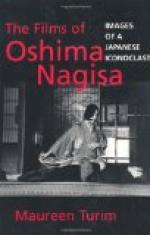|
This section contains 249 words (approx. 1 page at 300 words per page) |

|
Oshima's [The Man Who Left His Will on Film and The Ceremony] represent the two directions of his thinking. The Man Who Left His Will on Film is totally absorbed in the student struggle for power in the Tokyo of the late Sixties, and its style is correspondingly harsh and febrile, like Shinjuku Thief. The Ceremony, however, has the formal appeal of emotions recollected, sifted, assessed….
The Man Who Left His Will on Film is in black-and-white, and shot mostly with a hand-held camera. The Ceremony is in scope and colour, its starched gatherings recalling Ozu. Yet both films are obsessed with suicide…. In the earlier work, Oshima is using film as a weapon, creating a powerful dialectic in the conversations between Motoki and his girl friend Yasuko until the truth … seems impossible to disentangle from illusion. In The Ceremony, Oshima emphasises the artificial atmosphere of much Japanese...
|
This section contains 249 words (approx. 1 page at 300 words per page) |

|


